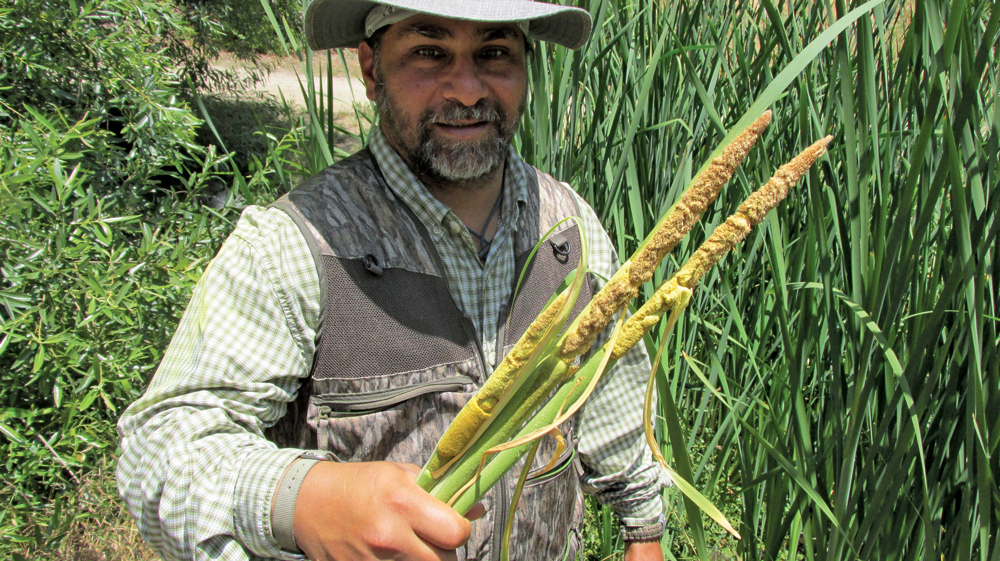The Remarkable Cattail—A Source For Food, Shelter and Other Necessities
Name: Cattail
(Typha sp.)
The cattail family consists of just two genera and about 32 species worldwide. The genus, Typha, to which cattails belong, consists of about 15 species worldwide.
Description
Cattails are those grass-like plants, common in the swamps, whose seed spikes look like a hotdog on a stick. Always growing in slow-moving waters or along the edges of streams, cattail has long, flat leaves that grow 6 feet long or longer, arising from underground horizontal rhizomes.
Where Found
Cattails are always found growing in wetlands, along the edges of lakes and streams, and often in roadside ditches.
When to Harvest/Availability
The pollen, new shoots and green spikes are available in the spring. The rhizomes can be collected anytime.
Uses
Are cattails edible? There are at least four good food sources from the cattail.
In the spring, the plant sends up its green shoots. If you get to them while they’re still flexible, you can tug them up. The shoots break off from the rhizome. You then cut the lower 12 inches or so and peel off the green layers. The inner white layer is eaten raw or cooked. It looks like a green onion, but the flavor is like cucumber.

The edible spike is the lower part of the flower spike—technically, the “female” part of the flower. You find the spike in spring, when it’s entirely green and tender. Although you can eat it raw, it’s far better after it’s boiled. Cook it, butter it and eat it like corn on the cob. Guess what? It even tastes like corn on the cob!
The pollen is the fine, yellow material you can shake out of the tops of the flower spikes. The pollen is at its peak about April or May, when you can shake lots of it into a bag, strain it (to remove twigs and bugs) and use it in any pastry product.

The rhizome is also a good starchy food. Pull out the long, horizontal roots from the mud, wash them and then peel off the soft outer layer. You could just chew on the inner part of the rhizome if you need the energy from the natural sugar, or you could process it a bit, as discussed next.
Processing
The pollen is merely shaken from the spike and sifted (to remove bugs and debris) before being used.
The young shoots require simple rinsing before they’re added to raw or cooked dishes.
The green spikes need only to be boiled.
One method of processing the rhizomes involves mashing or grinding up the inner rhizome and then putting it into a jar of water. As the solution settles, the pure starch will be on the bottom, and the fiber will be floating on the top, so you can easily scoop it out and discard it. The starch is then used in soups or in pastry and bread products.

Medicine/Nutrition
In Daniel Moerman’s Native American Ethnobotany, he describes many of the medicinal uses of the cattail. An infusion of the root is used to treat cuts and various skin disorders. Also, the “down” of the mature flower spikes has been used as a dressing for burns and wounds.
Other Uses
Aside from cooking them, the cattail’s long, green leaves have a lengthy history of being made into various useful woven products such as baskets, sandals, hats and even for the outer layers of the homes utilized by many of the natives of old California. And, when that cattail spike matures to a chocolate-brown color, you can break it open, and it all turns into an insulating fluff. You can use that fluff to stop the bleeding of a minor wound; as an alternative to down when stuffing a sleeping bag or coat; and as a fantastic fire starter.

Growing Advice
Cattails spread readily on their own. If you have a body of water nearby and you want to introduce cattails to its edges, just obtain a mature brown cattail spike and break up the spike where you want it to grow. If you see cattails growing naturally in your area—and the conditions in your pond or lake are right—some will sprout.
Cautions
If the water from which you are collecting cattails is impure, be sure to thoroughly cook any foods that you prepare from those cattails.
Recipes
Cattails “on the Cob”
This is a simple way to cook and serve cattails. Collect the flower spikes in the spring, when they’re still tender. Boil for 5 minutes. Drain, butter and serve immediately. Eat them like corn on the cob. Your guests will enjoy these!
Cattail Cakes
- 1 cup yellow cattail pollen
- 1¼ cups whole wheat pastry flour
- 1 egg
- 1 cup milk (or almond milk)
- 1½ tablespoons honey
Mix all the ingredients together. Thin or thicken to your desired consistency. Bake in a 350 degree (F) oven for 30 minutes.
You can also make this batter thinner by adding extra water or milk and then use the batter to make pancakes.
About ASG’s Plant Advisor
Christopher Nyerges has been teaching ethnobotany since 1974. He is the author of Guide to Wild Foods and Useful Plants, Foraging Wild Edible Plants of North America and other books on the uses of wild plants. He can be reached at SchoolofSelf-Reliance.com.
Editor’s Note: A version of this article first appeared in the July, 2020 print issue of American Survival Guide.


